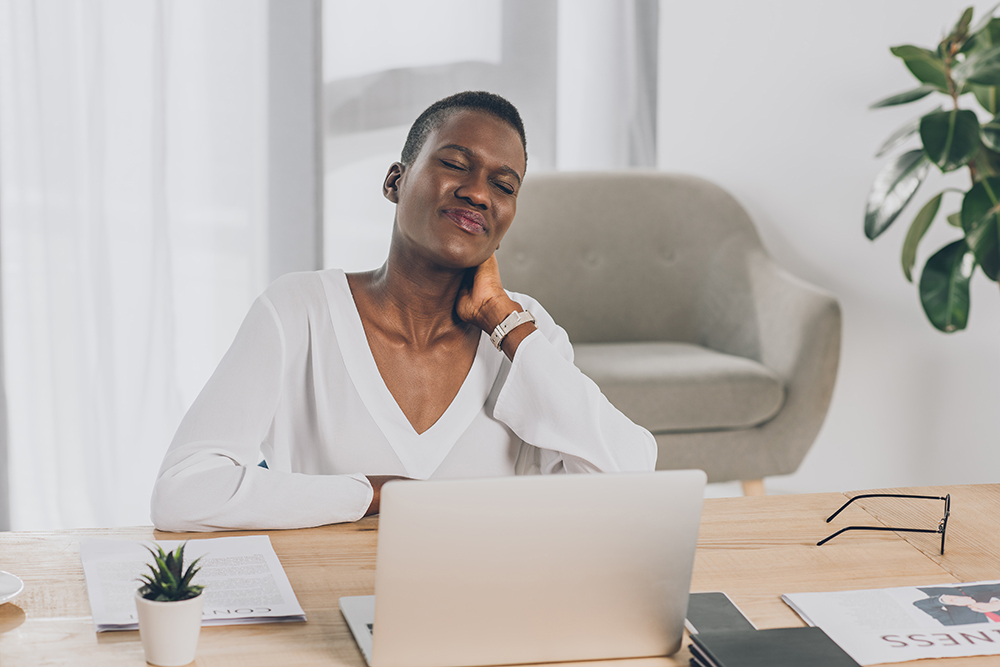Contents
Are you experiencing neck pain and stiffness on one side of your neck? A stiff neck can make even simple motions like head nods much more difficult. If you’re experiencing neck pain and stiffness, you’re not alone. Research shows that neck pain is one of the most common musculoskeletal disorders in the world. Fortunately, relief is possible. If one side of your neck feels stiff, targeted physical therapy treatments can help you address your discomfort. Physical therapists can address neck pain through an array of treatments, with specialized exercises playing a crucial role. Your physical therapist can help you practice exercises that reduce tension and offer lasting relief from your neck stiffness.
5 great PT exercises for a stiff neck on one side
- Neck rotation — Does your neck feel tight on one side? Whether the cause is a stiff muscle or a recent injury, doing a few neck rotations may help. This exercise serves to loosen neck muscles and improve circulation. To start this exercise, sit or stand with your back straightened. Maintaining proper posture, slowly turn your head to the left. Next, lower your chin toward your left shoulder. You should feel a stretch in the right side of your neck. After holding the stretch for a few seconds, release and switch sides. This exercise specifically targets the sides of your neck, which makes it a great option when you’re feeling localized stiffness around one side of your neck.
- Chin tuck — As with neck rotations and most other neck exercises, chin tucks should be done while maintaining a good posture. Proper posture helps your spine stay aligned, which can help your neck move naturally. From a straightened sitting or standing position, you can start doing this exercise by tucking your chin down toward your chest. If you’re having trouble visualizing this motion, it can help to imagine you’re trying to create a double chin. You may feel this exercise engaging the muscles in the back of your neck. Try to hold the tuck for 10 seconds before releasing, and repeat around 10-15 times.
- Neck side stretch — Neck side stretches can be effective for relieving tension around the sides of your neck. To do this exercise, start by tilting your head to one side. Try to bring your ear to your shoulder without raising your shoulders. If needed, you can use your hand to gently press your head to the side. When your head is fully tilted to one side, you should feel a stretch on the other side of your neck. Try to hold the stretch for around 10 seconds; then release and switch sides.
- Upper trap stretch — Your upper trapezius muscles run between your shoulders and the sides of your neck. If these muscles are tight or sore, they can contribute to localized pain. To address this pain, you can stretch your trapezius muscles. Start with your shoulders relaxed. Then, reach your left arm up over your head and rest your palm on the right side of your face. Keeping your shoulders relaxed, use your left hand to gently pull your head down toward your left shoulder. This exercise should feel similar to other neck side stretches. However, it differs in the way it specifically targets the trapezius muscles. Your physical therapist can help you figure out whether shoulder tension is contributing to your neck pain. This can help you decide which areas to target with your stretches.
- Shoulder blade squeeze — Shoulder blade squeezes can be a great way to open up your back as well as loosen your neck muscles. To do this exercise, sit or stand with your arms straight at your sides. Next, squeeze your shoulder blades together and push your chest forward. Try to hold for five seconds; then release. Frequently engaging in exercises like this can strengthen your upper back muscles and improve your neck alignment.
Why is my neck stiff on one side?
Learning about some potential causes may help you learn about your own condition. Your physical therapist will do an evaluation to identify the cause of your neck stiffness. Here are some possible causes of a stiff neck on one side:
- Sleeping position — Your sleeping position can have a major impact on your comfort levels through the night and day. If you’re often waking up with a stiff neck, the cause could be your sleeping position. Some sleeping positions put extra pressure on the neck, which can lead to strain and stiffness. Overall, sleeping on your back tends to be the best position for maintaining spinal alignment. Side and stomach sleeping positions can distribute your weight unevenly and cause muscle tension. Stomach sleeping tends to have an especially negative impact on the neck. By changing your sleeping position, you may be able to find relief and prevent future neck stiffness.
- Stress — Emotional and mental stress can affect your physical health. Persistent stress can create muscle tension, which can make your neck feel stiff. By practicing relaxation techniques, you may be able to find relief from your mental and physical symptoms. Your physical therapist can help you engage in techniques, such as targeted stretches, designed to release muscle tension.
- Injury — Have you recently sustained a neck injury? If so, your neck stiffness could be a lingering symptom. Neck stiffness can also develop due to injuries in nearby areas. For example, a shoulder injury may put tension on your neck. While your shoulder muscles are in recovery, your neck may feel stiff and painful as it bears excess weight normally carried by the shoulder. Whether you’ve been injured while playing a sport or in a motor vehicle accident, physical therapy can play a crucial role in your recovery journey.
How to treat a stiff neck on one side: 2 PT treatments
Exercises alone may not be sufficient to relieve your neck stiffness. If you need further treatment, your physical therapist can use other evidence-based approaches. Here are two ways your physical therapist may address your stiff neck:
- Manual therapy — With manual therapy techniques, your physical therapist can use their hands to directly address your symptoms. Manual therapy can be great for relieving pain, reducing tension and stimulating blood flow. Your physical therapist will tailor their techniques to your particular condition. If your neck stiffness is caused by a trigger point, for example, they may incorporate trigger point therapy into your treatment. Trigger points are tight, contracted areas of muscle tissue sometimes referred to as muscle knots. By applying controlled pressure to the tight muscle, your physical therapist can help release the knot and alleviate your stiffness. Like other physical therapy treatment methods, this approach can be modified to match your particular needs.
- Ergonomics — Poor posture is a common cause of neck pain and stiffness. With proper ergonomics, you can prevent these issues and, in turn, avoid further neck stiffness in the future. Ergonomics is all about improving the way people engage with their environment. Your physical therapist can help you incorporate ergonomics into your home and work spaces. For example, they may recommend using an ergonomic chair when using your home computer. Your physical therapist can also help you practice proper posture, reducing the pressure on your neck.
Lattimore Physical Therapy can help alleviate your neck stiffness
At Lattimore Physical Therapy, we offer tailored physical therapy treatment for neck injuries and other conditions. We can evaluate your condition and find a solution that works to keep your neck flexible.
Contact our team today for more information or to schedule an initial appointment.



